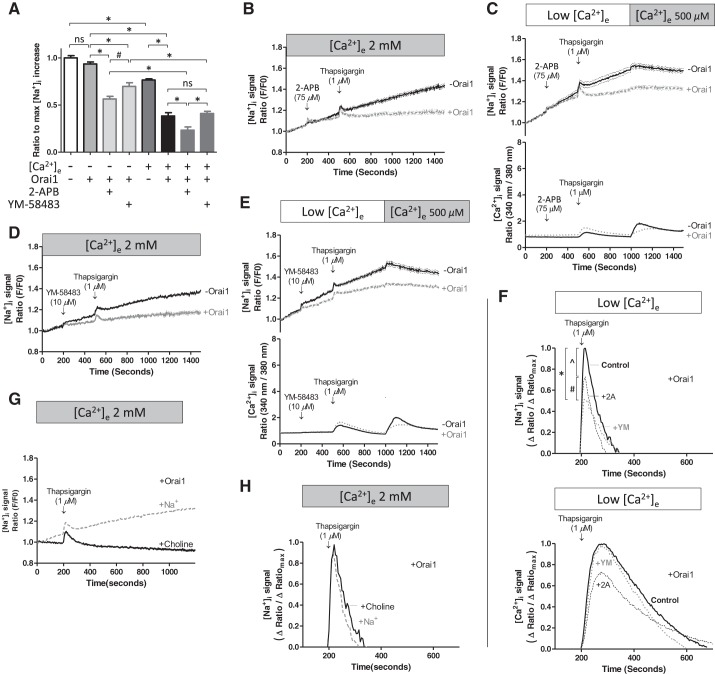Fig. 7.
Store-operated calcium entry and calcium release-activated calcium channel inhibitors 2-aminoethoxydiphenyl borate (2-APB) and YM-58483 decrease basal sodium leak and thapsigargin-induced sodium entry only in the presence of Orai1. PAECs were treated with doxycycline as described in Fig. 2 legend and loaded with ANG 2-AM or fura 2-AM. A: baseline sodium. In separate experiments, 2-APB or YM-58483 was added. Orai1 and extracellular calcium (2 mM) together potently limit basal sodium leak. 2-APB (75 μM) and YM-58483 (10 μM) suppress cytosolic sodium, but only in the presence of Orai1. The following studies were conducted in the absence of [Ca2+]e: for studies conducted in the absence of Orai1, data represent 6 experiments in which 67 cells were analyzed; for studies conducted in the presence of Orai1, data represent 8 experiments in which 88 cells were analyzed; for studies conducted in the presence of Orai1 and 2-APB, data represent 7 experiments in which 77 cells were analyzed; for studies conducted in the presence of Orai1 and YM-58483, data represent 5 experiments in which 55 cells were analyzed. The following studies were conducted in the presence of [Ca2+]e: for studies conducted in the absence of Orai1, data represent 6 experiments in which 65 cells were analyzed; for studies conducted in the presence of Orai1, data represent 6 experiments in which 67 cells were analyzed; for studies conducted in the presence of Orai1 and 2-APB, data represent 5 experiments in which 54 cells were analyzed; for studies conducted in the presence of Orai1 and YM-58483, data represent 6 experiments in which 63 cells were analyzed. Data were analyzed using 1-way ANOVA with Bonferroni's post hoc test: *P < 0.0001; #P < 0.01. B–E: after baseline sodium and calcium signals were measured, 2-APB (B and C) or YM-58483 (D and E) was added, followed by thapsigargin in the presence or absence of extracellular calcium. In the presence of 2 mM extracellular calcium, 2-APB (for studies conducted in the presence of Orai1, data represent 5 experiments in which 53 cells were analyzed; for studies conducted in the absence of Orai1, data represent 6 experiments in which 66 cells were analyzed) and YM-58483 (for studies conducted in the presence of Orai1, data represent 6 experiments in which 66 cells were analyzed; for studies conducted in the absence of Orai1, data represent 5 experiments in which 55 cells were analyzed) inhibited thapsigargin-induced sodium entry, but only in the presence of Orai1. In recalcification studies, 2-APB (for studies conducted in the presence of Orai1, data represent 6 experiments in which 66 cells were analyzed; for studies conducted in the absence of Orai1, data represent 5 experiments in which 55 cells were analyzed) and YM-58483 (for studies conducted in the presence of Orai1, data represent 5 experiments in which 55 cells were analyzed; for studies conducted in the absence of Orai1, data represent 7 experiments in which 77 cells were analyzed) again inhibited the thapsigargin-induced increase in cytosolic sodium, only in the presence of Orai1. 2-APB (for studies conducted in the presence of Orai1, data represent 4 experiments; for studies conducted in the absence of Orai1, data represent 4 experiments) and YM-58483 (for studies conducted in the presence of Orai1, data represent 5 experiments; for studies conducted in the absence of Orai1, data represent 7 experiments) decreased the thapsigargin-induced increase in cytosolic calcium, independent of Orai1. Values are means ± SE. F: transient thapsigargin-induced increases in cytosolic sodium and calcium were rescaled as percentage of maximal response. 2-APB and YM-58483 reduced the peak cytosolic sodium response to thapsigargin, whereas only 2-APB decreased the peak cytosolic calcium response to thapsigargin. For [Na+]i peaks: *P < 0.0001; ^P < 0.001; #P < 0.01. For [Ca2+]i peaks, P = not significant. G and H: extracellular sodium was replaced with choline, and the thapsigargin-induced cytosolic sodium response was evaluated. Choline substitution abolished thapsigargin-induced sustained increase in cytosolic sodium (G) but did not alter the transient increase in cytosolic sodium (H).

